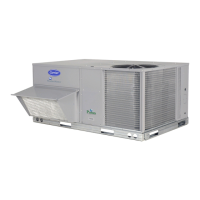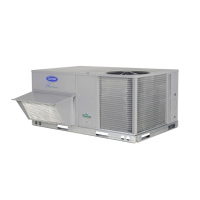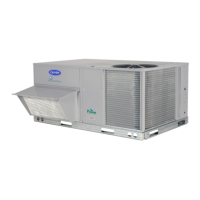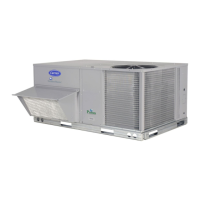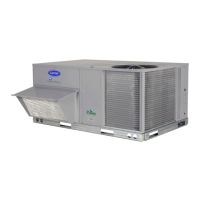38
To connect the sensor to the control, identify the positive
(4 to 20 mA) and ground (SIG COM) terminals on the
sensor. See Fig. 46. Connect the 4−20 mA terminal to the
RTU Open controller at J4−2 and connect the SIG COM
terminal to the RTU Open controller at J4−3. See Fig. 60.
SEN
COM
J4-2
J4-3
IAQ Sensor
24 VAC
C08462
Fig. 60 − RTU Open Controller / Indoor CO
2
Sensor
(33ZCSENCO2) Connections
Outdoor Air Quality Sensor
(P/N 33ZCSENCO2 plus weatherproof enclosure) —
The outdoor air CO
2
sensor is designed to monitor carbon
dioxide (CO
2
) levels in the outside ventilation air and
interface with the ventilation damper in an HVAC system.
The OAQ sensor is packaged with an outdoor cover. See
Fig. 48. The outdoor air CO
2
sensor must be located in the
economizer outside air hood.
Wiring the Outdoor Air CO
2
Sensor: A dedicated
power supply is required for this sensor. A two−wire cable
is required to wire the dedicated power supply for the
sensor. The two wires should be connected to the power
supply and terminals 1 and 2.
To connect the sensor to the control, identify the positive
(4 to 20 mA) and ground (SIG COM) terminals on the
OAQ sensor. See Fig. 46. Connect the 4 to 20 mA
terminal to the RTU Open controller at J4−5. Connect the
SIG COM terminal to the RTU Open controller at J4−6.
SEN
COM
J4-5
J4-6
OAQ Sensor
24 VAC
C11086
Fig. 61 − RTU Open Controller / Outdoor CO
2
Sensor
(33ZCSENCO2) Connections
Space Relative Humidity Sensor—
The Space Relative Humidity Sensor is not used with
50HCQ units at this time.
Smoke Detector/Fire Shutdown (FSD) —
On 50HCQ units equipped with factory−installed Smoke
Detector(s), the smoke detector controller implements the
unit shutdown through its NC contact set connected to the
unit’s CTB input. The FSD function is initiated via the
smoke detector’s Alarm NO contact set. The RTU Open
controller communicates the smoke detector’s tripped
status to the BAS building control. See Fig. 56 (Typical
RTU Open Controller wiring schematics).
The Fire Shutdown Switch configuration,
MENU"Config"Inputs"input 5, identifies the normally
open status of this input when there is no fire alarm.
Connecting Discrete Inputs —
Filter Status: The filter status accessory is a
field−installed accessory. This accessory detects plugged
filters. When installing this accessory, the unit must be
configured for filter status by setting
MENU"Config"Inputs"input 3, 5, 8, or 9 to Filter
Status and normally open (N/O) or normally closed (N/C).
Input 8 or 9 is recommended for easy of installation. Refer
to Fig. 55 and Fig. 56 for wire terminations at J5.
Fan Status: The fan status accessory is a field−installed
accessory. This accessory detects when the indoor fan is
blowing air. When installing this accessory, the unit must be
configured for fan status by setting
MENU"Config"Inputs"input 3, 5, 8, or 9 to Fan Status
and normally open (N/O) or normally closed (N/C). Input 8
or 9 is recommended for easy of installation. Refer to Fig.
55 and Fig. 56 for wire terminations at J5.
Remote Occupancy: The remote occupancy accessory is
a field−installed accessory. This accessory overrides the
unoccupied mode and puts the unit in occupied mode.
When installing this accessory, the unit must be
configured for remote occupancy by setting
MENU"Config"Inputs"input 3, 5, 8, or 9 to Remote
Occupancy and normally open (N/O) or normally closed
(N/C).
Also set MENU"Schedules"occupancy source to DI
on/off. Input 8 or 9 is recommended for ease of
installation. Refer to Fig. 55 and Table 13 for wire
terminations at J5.
Power Exhaust (output): The relay used by the RTU
Open controller board to control power exhaust is a dry
contact which means it does not have 24vac. This 24vac
must be connected to the relay to allow it to operate the
power exhaust relay in the PE accessory. A 24vac source
must be provided to J11−2 on the RTU Open controller
board. This can be provided by the unit’s transformer from
various sources. The “R” terminal on the unit’s low
voltage terminal board (LVTB) is a logical source. Refer
to Fig. 55 and Fig. 56 for wire terminations at J11.
Communication Wiring − Protocols
General —
Protocols are the communication languages spoken by
control devices. The main purpose of a protocol is to
communicate information in the most efficient method
possible. Different protocols exist to provide different
kinds of information for different applications. In the BAS
application, many different protocols are used, depending
on manufacturer. Protocols do not change the function of
a controller; just make the front end user different.
The RTU Open controller can be set to communicate on
four different protocols: BACnet, Modbus, N2, and
50HCQ

